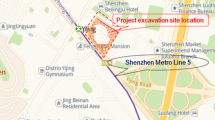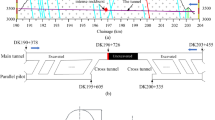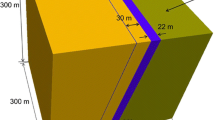Abstract
Fault reactivation is a common and important engineering geological phenomenon. However, the surface expressions and intensity of reactivated faults adjacent to open-pit mines can vary with the engineering geological conditions. In this study, several types of fault reactivation were identified and studied based on geological investigations conducted at an open-pit mine in China. Based on these studies, a comparatively simple physical simulation method was employed to analyze the causes of fault reactivation under self-weight stress conditions. For a steeply dipping fault which outcrops in the tensile zone of an excavated slope, the tensile stresses generated perpendicular to the fault surface usually result in normal fault-style movement, regardless of the orientation of the fault. For a steeply dipping fault which outcrops in the compressional zone of an excavated slope, an outward-dipping fault usually generates reverse fault-style movement, whereas an inward-dipping fault usually generates normal fault-style movement. For a low-angled and inward-dipping fault, reverse fault-style movement could be induced because of the self-weight body forces of the hanging wall slope. Flexural toppling failure of an excavated slope was simulated by a series of inward-dipping faults. The simulated scarp sizes and deflections of the reactivated faults increased along the excavated slope.








Similar content being viewed by others
References
Adhikary DP, Dyskin AV (2007) Modelling of progressive and instantaneous failures of foliated rock slopes. Rock Mech Rock Eng 40(4):349–362
Adhikary D, Dyskin A, Jewell R, Stewart D (1997) A study of the mechanism of flexural toppling failure of rock slopes. Rock Mech Rock Eng 30(2):75–93
Amini M, Majdi A, Aydan Ö (2009) Stability analysis and the stabilisation of flexural toppling failure. Rock Mech Rock Eng 42(5):751–782
Bray JW, Goodman RE (1981) The theory of base friction models. Int J Rock Mech Min Sci Geomech Abstr 18(6):453–468
Bruneau G, Tyler DB, Hadjigeorgiou J, Potvin Y (2003) Influence of faulting on a mine shaft—a case study: part I—background and instrumentation. Int J Rock Mech Min Sci 40(1):95–111
Carpinteri A, Paggi M (2008) Size-scale effects on strength, friction and fracture energy of faults: a unified interpretation according to fractal geometry. Rock Mech Rock Eng 41(5):735–746
Donnelly LJ (2005) Fault reactivation in South Wales and the effects of on ground stability. In: Nichol D, Basssett MG, Deisler VK (eds) The urban geology of Wales 2. National Museum of Wales Geological Series 24. National Museum of Wales, Cardiff, pp 101–119
Donnelly LJ (2006) A review of coal mining induced fault reactivation in Great Britain. Q J Eng Geol Hydrogeol 39(1):5–50
Donnelly LJ (2009) A review of international cases of fault reactivation during mining subsidence and fluid abstraction. Q J Eng Geol Hydrogeol 42(1):73–94
Donnelly LJ, Reddish DJ (1994) The development of surface steps during mining subsidence: not due to fault reactivation. Eng Geol 36:243–255
Donnelly LJ, Northmore KJ, Siddle HJ (2000) Lateral spreading of moorland in South Wales. In: Siddle HJ, Bromhead EN, Bassett MG (eds) Landslides and landslide management in South Wales. National Museum and Galleries of Wales Geological Series 18. National Museum and Galleries of Wales, Cardiff, pp 43–48
Donnelly LJ, Northmore KJ, Siddle HJ (2002) Block movements in the Pennines and South Wales and their association with landslides. Q J Eng Geol Hydrogeol 35(1):33–39
Hencher SR, Liao Q-H, Monaghan BG (1996) Modelling slope behaviour for open-pits. Trans Inst Min Metall Sect A Min Ind 105:A37–A47
Islam M (2009) Mining-induced fault reactivation associated with the main conveyor belt roadway and safety of the Barapukuria coal mine in Bangladesh: constraints from BEM simulations. Int J Coal Geol 79(4):115–130
Jhanwar J, Thote N (2011) Slope failures in the opencast coal mines of Wardha valley coalfield in central India: a study. Rock Mech Rock Eng 44(5):635–640
Jiang JP, Gao GY (2003) Analysis of non-uniform settlement at the ground induced by underground engineering. J China Coal Soc 28(3):225–229 (in Chinese with English abstract)
Kamata H, Mashimo H (2001) Centrifuge model test of tunnel face reinforcement by bolting. In: Adachi T (ed) Modern tunneling science and technology. Balkema, Rotterdam, pp 177–182
Lee A (1965) The effects of faulting on mining subsidence. Min Eng 125:735–745
Li X, Zhang GY, Luo GY (2003) Barrier effects caused by fault on excavating-induced stress and deformation and mechanism of resulting groundwater inrush. Rock Soil Mech 24(2):220–224 (in Chinese with English abstract)
Nagelhout ACG, Roest JPA (1997) Investigating fault slip in a model of an underground gas storage facility. Int J Rock Mech Min Sci 34(3–4):212.e211–212.e214
Resnick GS (1990) Centrifugal modeling of drains for slope stabilization. J Geotech Eng 116(11):1607–1624
Shepherd J, Fischer NI (1978) Faults and their effect on coal mine roof failure and mining rate: a case study in a new South Wales colliery. Eng Geol 30(9):1325–1334
Sjöberg J (2000) Failure mechanism for high slopes in hard rock. In Hustrulid WA, McCarter MK, Van Zyl DJA (eds) Slope stability in surface mining. Society of Mining, Metallurgy and Exploration, Littleton, pp 71–80
Stacey TR (2006) Considerations of failure mechanisms associated with rock slope instability and consequences for stability analysis. J S Afr Inst Min Metall 105:485–493
Tao ZY, Zhang LM (1991) Study of factors relative to the fault reactivation. In: Proc Int Symp on Rock Joints, Loen, Norway, 4–6 June 1990, pp 487–493
Whittaker BN, Reddish DJ (1989) Subsidence: occurrence, prediction and control. Elsevier, Amsterdam, p 528
Wu Q, Wang M, Wu X (2004) Investigations of groundwater bursting into coal mine seam floors from fault zones. Int J Rock Mech Min Sci 41(4):557–571
Xie HP, Yu GM, Yang L, Zhou HW (1998) The influence of proximate fault morphology on ground subsidence due to extraction. Int J Rock Mech Min Sci 35(8):1107–1111
Xu RC (1988) The studies of rock mass deformation deep-digging base pit slope of II river and its engineering treatment measure in Gezhouba Hydro-electric power station. In: Sun GZ (ed) Typical landslides in China. Science Press, Beijing, pp 290–300 (in Chinese)
Xu JM (1995) Study of the engineering geological problems indued by mining the western Fushun open-pit mine of China. In: Wang SJ (ed) Study on interaction of engineering activities and geological environment (2). Seismological Press, Beijing, pp 116–156 (in Chinese)
Xu JM (1998) Engineering geomechanics of slope rock mass in Jinchuan mine. Geological Publishing House, Beijing (in Chinese)
Xu RC (2003) Red bed and dam. China University of Geosciences Press, Wuhan (in Chinese)
Xu JM, Li X, Han BC (2006) Original state of strain energy in a rock mass and its effect on excavation-induced displacement fields. Int J Rock Mech Min Sci 25(12):2467–2474 (in Chinese with English abstract)
Yeung MR (1999) Sliding and toppling of rigid blocks under base friction. In: Amadei K, Scott S (eds) Proceedings of Rock Mechanics for Industry. Balkema, Rotterdam, pp 559–566
Zhang JH, Chen ZY, Wang XG (2007) Centrifuge modeling of rock slopes susceptible to block toppling. Rock Mech Rock Eng 40(4):363–382
Zhang ZX, Xu Y, Kulatilake PHSW, Huang X (2012) Physical model test and numerical analysis on the behavior of stratified rock masses during underground excavation. Int J Rock Mech Min Sci 49:134–147
Acknowledgments
The study was sponsored by the National Natural Science Foundation of China (grant nos. 41002107, 41172271, and 41030750) and was a China Postdoctoral Science Foundation funded project (Grant No. 2012M510542). Grateful appreciation is expressed for this support.
Author information
Authors and Affiliations
Corresponding author
Rights and permissions
About this article
Cite this article
Zhao, H., Ma, F., Xu, J. et al. Experimental investigations of fault reactivation induced by slope excavations in China. Bull Eng Geol Environ 73, 891–901 (2014). https://doi.org/10.1007/s10064-013-0569-1
Received:
Accepted:
Published:
Issue Date:
DOI: https://doi.org/10.1007/s10064-013-0569-1




